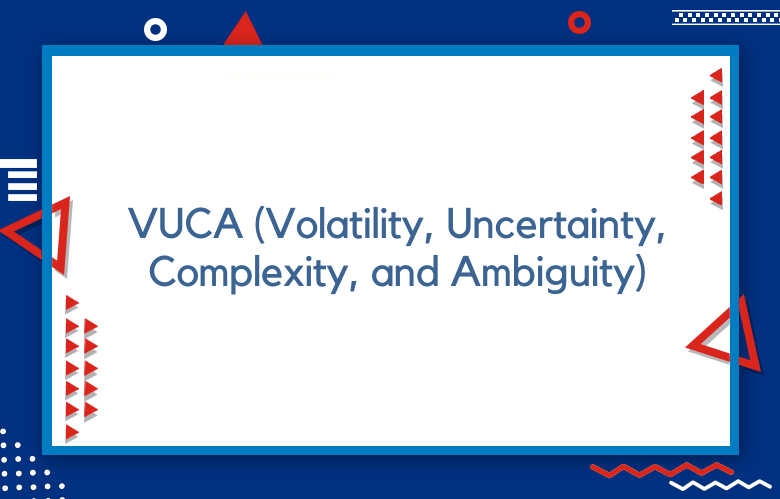What is VUCA (Volatility, Uncertainty, Complexity, and Ambiguity)?

In the modern business world, being prepared for any situation is more critical than ever.
This is where understanding the concept of VUCA comes into play. VUCA stands for volatility, uncertainty, complexity, and ambiguity and describes the world we live in today.
We will discuss VUCA and how to use it to your advantage in business.
What is VUCA (Volatility, Uncertainty, Complexity, and Ambiguity)?
VUCA is an acronym for volatility, uncertainty, complexity, and ambiguity. The U.S. initially coined it.
Army War College to describe the complex and unpredictable world that they faced in the post-Cold War era.
The term has since become widely adopted across business and management circles, with many experts using it to refer to various challenges facing organizations today.
Volatility refers to rapid changes in market conditions or the environment that can occur in short periods.
This could be changed by customer demand, technological advances, economic recessions, or even natural disasters.
Businesses must be prepared for such scenario shifts as these can seriously impact their operations.
VUCA stands for volatility, uncertainty, complexity, and ambiguity. It is a term used to describe the current environment of the 21st century, and advancements have accelerated in technology and globalization. The concept has been credited to the United States Army War College as early as 1987 but has become increasingly popular.
Volatility refers to the nature of environments that are constantly changing and unpredictable. For example, economic crises can cause rapid shifts in markets, or political events can have unexpected consequences that result in a drastic change. This kind of instability makes predicting future outcomes a challenging proposition.
Uncertainty pertains to situations where outcomes need to be clarified or predetermined, making it difficult to accurately gauge potential risks and rewards associated with any given decision.
We can always determine whether a specific course of action will succeed or fail; risk is always involved in any decision-making process.
Complexity exists when systems involve multiple variables and connections, making understanding how different parts interact difficult.
This could include understanding global networks of people and organizations, how data science works on large datasets, or even how a business operates across many departments.
Ambiguity involves situations where meanings are unclear or obscure due to a lack of knowledge or context.
This could mean that a problem is open to interpretation and requires further investigation before conclusions can be drawn, such as trying to interpret financial statements or analyzing customer feedback about a product launch without having all the necessary information.
Overall, VUCA provides a framework for understanding the characteristics of today’s environment and helps us prepare for what lies ahead as we move forward into an uncertain future.
By recognizing these traits and developing strategies that anticipate potential volatility, uncertainty, complexity, and ambiguity, we can better equip ourselves for dealing with whatever challenges come our way.
What do Volatility, Uncertainty, Complexity, and Ambiguity (VUCA) mean?
VUCA stands for volatility, uncertainty, complexity, and ambiguity.
Volatility refers to how quickly things can change; luck does not know what could happen; complexity is how complex a situation can be; and ambiguity is how unclear a problem can be.
These four elements all work together to define our world today.
Regarding business, VUCA can refer to anything from technological changes that could disrupt the industry.
These unexpected events could cause market fluctuations or new competitors to enter the market with unfamiliar strategies.
These factors create an environment of constant change and require businesses to stay agile and flexible to survive and thrive.
What do Volatility, Uncertainty, Complexity, and Ambiguity (VUCA)
VUCA stands for volatility, uncertainty, complexity, and ambiguity.
It is an acronym developed by the U.S. Army War College in 1987 to explain the post-Cold War world they were entering.
They saw this new world as volatile, uncertain, complex, and ambiguous – hence the acronym ‘VUCA’ was born!
Volatility is defined as frequent or sudden changes in direction or magnitude. For example, increasing oil prices or decreasing interest rates could have severe implications for many business sectors.
Uncertainty refers to an unclear future with multiple possible outcomes that cannot be predicted accurately. This could include economic events such as GDP growth changes, customer preferences, and buying patterns.
Complexity is when many interconnected components make up a system, which can be challenging to comprehend or manage due to their interdependencies, which can create unexpected results when adjusted.
How can You use Volatility, Uncertainty, Complexity, and Ambiguity (VUCA) to Your advantage?
The secret to success in this environment is anticipating change before it happens and acting accordingly.
Businesses must have strategies to deal with disruptions or changes in their industry and be prepared when they occur.
Companies should always stay informed about current trends and research new technologies to be aware of any possible changes or disruptions before they happen.
A plan for visiting Agile will help businesses pivot quickly when needed to maintain their competitive edge.
Understanding the Volatility, Uncertainty, Complexity, and Ambiguity (VUCA) Framework
The business world constantly changes, and organizations must stay ahead of the curve.
The VUCA framework helps you do this by identifying and preparing for risk.
VUCA stands for volatility, uncertainty, complexity, and ambiguity. Let’s explore each term in more detail.
Volatility
Refers to the degree of change an organization faces and how quickly those changes occur. Volatility can be caused by anything from natural disasters or economic downturns to new technologies or shifts in consumer behavior.
Understanding how volatility might affect your business is essential so you can plan accordingly and be prepared for whatever might come your way.
It is important to anticipate when changes are likely to happen so that an organization can be prepared for them.
For example, if a company expects a big product launch, it needs to anticipate how the market may respond and plan accordingly.
Uncertainty
Describes the need for more precise direction or information about future events and outcomes.
There often needs to be a clear answer when trying to predict what will happen in the future due to uncertainty.
As such, organizations must remain flexible to quickly adjust their plans in response to environmental changes or unexpected events.
Being able to embrace uncertainty allows businesses to better prepare for unexpected events and make decisions accordingly when faced with them.
Complexity
This relates to how interconnected different elements are within a system or organization.
This includes internal components (such as departments) and external components (such as customers).
It’s essential for businesses operating in complex environments not only to understand their operations but also to stay up-to-date on external factors so they can make informed decisions about their prospects.
Understanding the complexity of a system enables organizations to make better decisions by considering all of its moving parts.
Ambiguity
Ambiguity describes situations where multiple interpretations of data or information are available.
This could include conflicting stakeholder messages or more explicit instructions from management teams.
Understanding ambiguity means having the ability to identify potential risks and opportunities.
Within an environment while being aware that those risks may never materialize into anything tangible if managed correctly.
Ambiguity requires organizations to think critically about possible solutions before making any decisions and ensure that everyone involved understands exactly what is expected from them for success.
Conclusion
In conclusion, understanding VUCA (volatility, uncertainty, complexity & ambiguity) is essential for any modern business looking to succeed in today’s ever-changing business landscape.
I have strategies to anticipate change before it happens and stay informed on current trends & technologies.
Will help businesses remain agile & flexible while still maintaining their competitive edge no matter what disruptive forces come their way!
Call: +91 9848321284
Email: [email protected]



